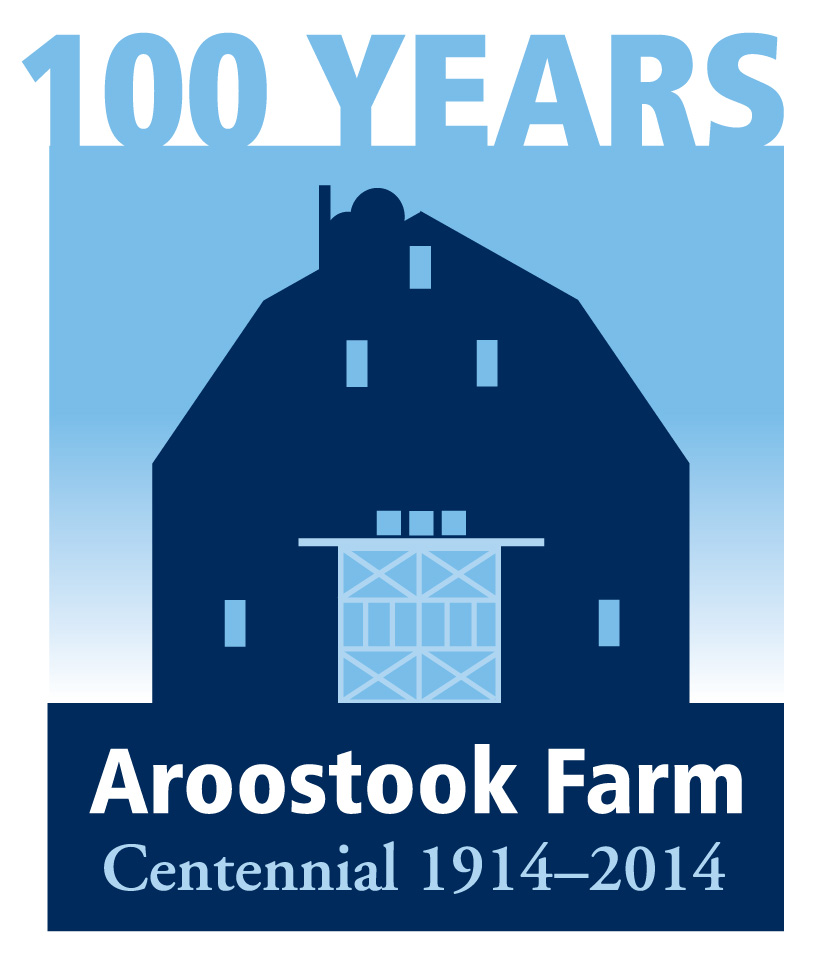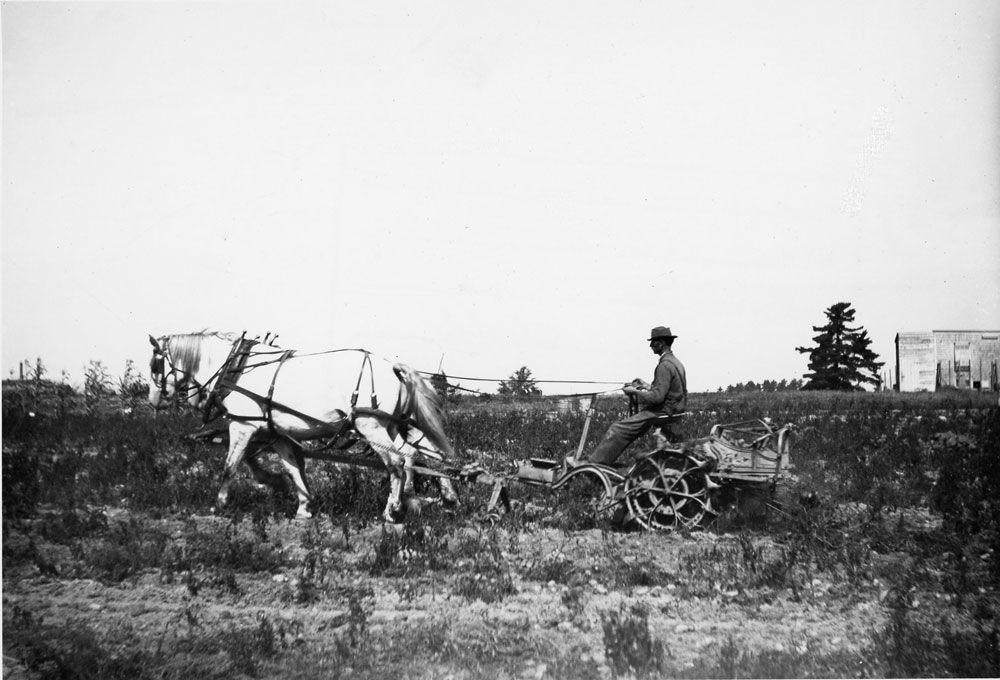100 Years of Research at Aroostook Farm
In 1912 a committee of farmers from Aroostook County appealed to the legislature to appropriate funds to purchase a local farm to better study soil, climate, and cropping practices for the region. After looking at various pieces of land, a committee decided to purchase 275 acres about a mile and a half south of Presque Isle village, a property known as the Greenwood Farm. The asking price was $20,000 even though the farmhouse had recently burned. Farmers and businessmen located in Presque Isle contributed toward the total cost of the land, and the station bought the property in 1914. In 1915 the legislature appropriated $18,000 for the farm.
In its early days, the farm was home to grain and potato experiments. Early research focused on tillage practices, such as the respective advantages of high-ridge versus shallow planting of potatoes and the seeding rate of oats. Work soon spread to fertilizers, comparing sulphate of ammonia and nitrate of soda as nitrogen sources and experimenting with methods of application. After the outbreak of World War I cut off German and Chilean sources of potash, an important mineral fertilizer, researchers on Aroostook Farm began experimenting with alternatives such as seaweed, manure, wood ash, and gypsum. Other research at the farm in this first decade included oat and wheat breeding, timothy improvement, and work on strawberry variety testing.
In the 1920s, research at Aroostook Farm focused on virus, fungus, and insect-transmitted diseases in potato plants. Researchers investigated such problems as leafroll, spindle-tuber, rhizoctonia, and the damage caused by aphids. These experiments continued throughout the next several decades. Beginning in the 1930s, research started focusing on issues affecting the culinary quality of potatoes, such as handling and storage. New uses for potatoes, such as potato chips, were becoming popular, and the research done at Aroostook Farm increasingly focused on how to get tasty, high-quality potatoes onto the plates of consumers. As potatoes became the staple crop in Aroostook County, economists at the University of Maine campus began studying the costs and returns of growing potatoes on privately owned farms throughout the county, and how best to market them to both in-state and out-of-state consumers.
The disease research continued through the 1940s and expanded to include bacterial ring rot, stem-end browning, mahogany browning, and purple-top. Economic studies paid special attention to the wartime conditions on farms. After World War II, a whole host of new chemical insecticides and fungicides, including DDT, became available, and much of the research at the farm was directed at figuring out how best to use them. The 1950s also saw and increased focus on mechanized harvesting and handling techniques on Aroostook Farm, while economists at the University of Maine in Orono worked to expand the market for Maine potatoes, for consumption and use as seed throughout the eastern United States.
This sort of work continued for the next several decades. Beginning in the 1990s, research turned towards establishing more ecologically sound management practices. In 1991, the Maine potato ecosystem study was launched. It was one of the first comprehensive studies to examine ecologically based, biologically efficient, and economically profitable management systems of an agricultural commodity. Recent research at Aroostook Farm includes development and testing of new potato varieties and investigations on the effects of cultural practices on potato growth, development, yield, and quality. To help with the problem of diseases of potatoes, scientists are investigating the molecular genetics of potato pathogens, developing new, faster methods to detect potato viruses in seed stock, and working to develop more disease-resistant potato varieties. Scientists also have investigated effects of soil amendments and crop rotation on soil properties and potato productivity and looking at how the use of manure and yard waste affects the soil.
Farm Superintendents
- 1915-1916 — Guy H. Baker
- 1916-1919 — Jeremiah S. Sullivan
- 1920 — Walter E. Curtis
- 1920-1922 — E. Raymond Rines
- 1922-1927 — Perley E. Downing
- 1927-1950 — Silas Hanson
- 1950-1971 — Roger M. Cobb
- 1971-1993 — Joseph A. Lloyd
- 1993-2001 — Malcolm E. Brown
- 2001-to date — Randy Smith
Timeline
- 1913 — Aroostook Farm purchased, including about 275 acres, a large barn with concrete potato house in basement, and a small dwelling house.
- 1914 — New eight-room house erected on Aroostook Farm in summer of 1914 to replace small one burned in July 1914.
- 1914 — Repairs made on the barn and potato storage at Aroostook Farm; scales and implements worth $3,000 were installed; and electricity installed in house and barn.
- 1917 — U. S. Department of Agriculture constructed potato storage house at Aroostook Farm with office for use of Department Horticulturist.
- 1919 — Repaired barn roof at Aroostook Farm which fell in, due to heavy load of snow, at cost of $1,695.
- 1919 — Findings from a long-term experiment on the role of aphids in spreading potato diseases begun in 1914 were published. Another long-term experiment on fertilization by insects was developed.
- 1923 — Katahdin potato variety first grown in 1923 at Aroostook Farm. Released in 1932 by the USDA and Maine Agricultural Experiment Station.
- 1925 — Farm boarding house burned down.
- 1926 — Farm boarding house at Aroostook Farm rebuilt in summer to replace one that burned the previous fall.
- 1931 — First full-time entomologist assigned to work on Aroostook Farm.
- Early 1930s — Ring rot is discovered in Aroostook County. Causes the breakdown of tubers both in the field and in storage, is easily spread through contact.
- 1932 — Sebago potato developed, a cross between Katahdin and Chippewa, with resistance to late blight. Released by the USDA and Maine Agricultural Experiment Station in 1938.
- 1938-1939 — Annis Farm purchased including slightly over 100 acres, adjoining Aroostook Farm on the north. Approximately 50 acres was available for potatoes which permitted shift from 2- to 3-year rotation. Some of the remaining 50 acres, which was in woods, could be cleared. The farm house was to be renovated for staff member apartments during the summer.
- 1940-1941 — Acquired Chapman Farm for use by USDA in potato breeding program.
- 1941-1942 — Two range greenhouses and a head house at Aroostook Farm completed about January 1, 1942, and used intensively for study of potato diseases. The cost of construction and operation paid from Potato Tax Funds.
- 1944 — DDT became available and was the focus of many experiments. It proved particularly effective against the Colorado potato beetle, almost completely eliminating the pest in Aroostook County.
- 1947-1948 — Construction started on experimental potato storage house at Aroostook Farm for studies of handling, grading, packing and storing potatoes—largely financed with Potato Tax Funds.
- 1954-1955 — Established Potato Handling Research Center at Aroostook Farm with agricultural economist and agricultural engineer from Station, and industrial engineer and physiologist from USDA.
- 1954-1955 — New machine shop at Aroostook Farm (40×42′); much of equipment provided by USDA.
- 1956-1957 — New isolation storage for seed potatoes in Aroostook Farm basement.
Cleared 8 acres of woodland at Aroostook Farm. - 1960s — variety trials began focusing on characteristics important to the frozen food industry.
- 1965-1966 — Greenhouse unit at Aroostook Farm, constructed by USDA, provided for cooperative
research on biological control of aphids, and was 50×22 feet, at cost of about
$30,000. - 1967-1968 — Deeded to City of Presque Isle the wooded area on back end of Aroostook
Farm for flooding and recreation area. - 1976 — Atlantic, a chipping variety, was released jointly by the USDA-ARS, University of Florida, University of Maine, Rutgers, and VPI-SU
- 1978 — BelRus, a russet potato variety adapted to the northeastern US and Florida, was released in May by the USDA-ARS, and Maine and Florida agricultural experiment stations
- 1985 — Geddes Simpson Potato Storage Building
- 1991 — Maine potato ecosystem study initiated. One of the first comprehensive studies to examine ecologically based, biologically efficient, and economically profitable management systems of an agricultural commodity
- 1991 — MaineChip, a medium-maturing chipping variety, was released
- 1995 — Aroostook Farm Laboratory Building
- 1996 — Quaggy Joe, round white tablestock potato variety, was released in May.
- 2003 — Potato Research Storage Facility completed. The new facility allows for potato storage research, an area vital to improving product quality and production efficiency as Maine potatoes reach competitive markets.
- 2004 — New greenhouse facility completed. The greenhouse, primarily funded by the bond referendum approved by Maine citizens in the summer of 2003, provides year-round potato research capabilities needed to support the potato industry in the state of Maine
- 2014 — Easton, a French fry processing potato, and Sebec, a chipping variety, potatoes released by University of Maine and the Maine Potato Board


